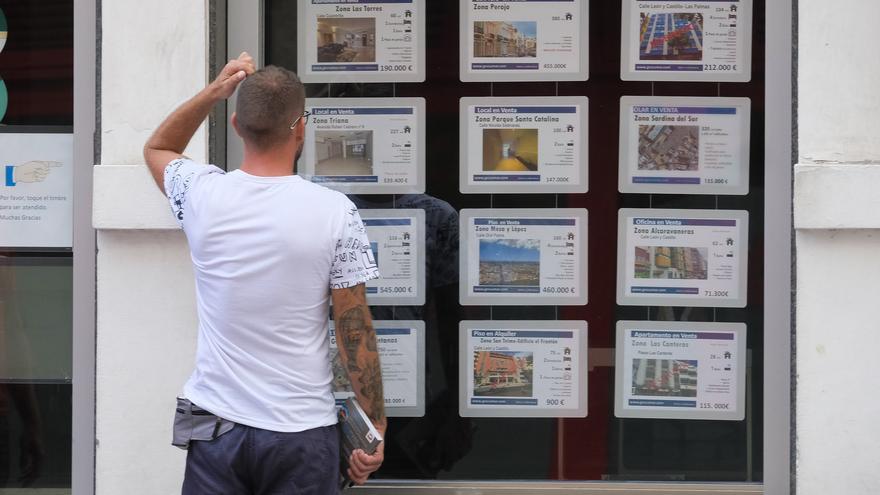
Buying a home in the Canary Islands is increasingly difficult. While in the Spanish territory as a whole prices tend to moderate, in the Islands they have been out of control for years. So much so, that the difference between what it cost to buy a house between 1997 and 2007 – during the so-called real estate bubble – and what it costs now is increasingly less noticeable. According to data from the latest report prepared by the Tinsa Group, the price per square meter in the Archipelago stood at 1,545 euros in the third quarter, which is barely 3.9% less than what it was during the real estate boom.
The recovery of the housing market since 2008 – when the real estate bubble burst – has been overwhelming. The price of real estate has increased by 37.4% on average in Spain. A percentage that has increased in the case of capitals and large cities (45.2%), Islands (41.5%) and metropolitan areas (40.4%).
Tinsa’s monthly data – which takes the Balearic Islands and the Canary Islands as a single market – reflects that in these two communities the price of housing grew by 2.3% in September and that the sum of the increase in the last 12 months is 8.9%. The rest of the groups, on the other hand, move in the stabilization environment, between -0.2% in capitals and large cities and +0.2% on the Mediterranean coast and other municipalities.
What are the reasons for these great differences between the Islands and other territories? According to Cristina Arias, director of the Tinsa Studies Service, the role of foreigners is fundamental and “has had greater weight during the first half of the year in the island territory and in some areas of the Mediterranean coast.”
Although home purchases in the Canary Islands remain on the rise thanks to foreign capital, it cannot be said that the Archipelago is immune to the inflationary wave. Arias explains that Spaniards have increasingly less purchasing power due to the “effect of inflation on household savings and the impact of rising interest rates.” This, in turn, translates into a “gradual moderation” in the sale of houses due to “fewer mortgage granting.”
As a positive counterpoint, Tinsa points out that “housing continues to channel savings.” And the fact is that the families that kept their jobs during the pandemic managed to gain an economic cushion thanks to the containment of spending – there was no possibility of going on vacation or allocating money to leisure – a savings that many now allocate to the purchase of a property.
Even better is the horizon that Arias foresees for the housing market for the coming months: «The maintenance of employment rates is allowing the solvency of households to be maintained, which will slowly recover their purchasing power as the economy moderates. inflation”.
Low salaries and high housing prices complicate access to housing on the Islands. In fact, according to the latest study published by Idealista – which includes data from the third quarter – the Canary Islands is one of the communities where the greatest effort must be made to buy and rent. Island families allocate 25% of their income to mortgages and 35% to rent. In the country as a whole, on the contrary, a family unit dedicates 21% of its income to paying the mortgage and 31% to rent.
The two provincial capitals of the Canary Islands are among the ten Spanish capitals where you have to make the greatest effort to rent a house and, on top of that, they are right at the 30% maximum that experts recommend allocating to paying for housing. The Spanish cities with the most expensive rents in proportion to salaries are Barcelona (43%), Palma (42%), Valencia (39%), Málaga (37%), Alicante (35%), Madrid (35%) and San Sebastian (33%). Bilbao equals the Canary capitals and stands at 30%.
In most of the cases that Idealista has studied, the effort of families has concluded that it is usually lower to buy than to rent, with the exception of the markets of San Sebastián, Palma, Granada and A Coruña. Furthermore, it points out that contrary to what happened last year, four capitals have effort rates higher than the 30% recommended by experts: Palma (47%), San Sebastián (38%), Málaga (33%) and Barcelona ( 32%).
In the case of mortgages, the Balearic Islands are the autonomous community that requires the greatest effort, with 45% of family income. They are followed by Málaga (43%), Santa Cruz de Tenerife (34%), Alicante (28%), Las Palmas (25%), Madrid (24%) and Cádiz (23%).
In purchasing, the markets of all regions require a greater effort than a year ago, with the cities of Palma (18 points more), Málaga (11 points), Santa Cruz de Tenerife (10 points) and San Sebastián (10 points) where it has grown the most. The smallest increase has occurred in Soria (2 points), Palencia, Toledo, Jaén, Teruel, Ciudad Real and Cuenca (3 points in all of them).
The increased cost of financing – due to the rise in interest rates – is the reason why families increasingly have to allocate a greater percentage of their salary to the purchase of their home. Thus, according to the Idealista report, a family has gone from having to spend 17% of its income in September 2022 on its mortgage, to having to allocate 21% in the last month. In the case of rent, the increase was just a few tenths.
















